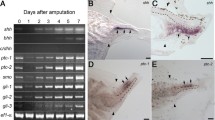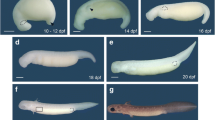Abstract
Homeosis, the ectopic formation of a body part, is one of the key phenomena that prompted the identification of the essential selector genes controlling body organization. Shared elements of such homeotic genes exist in all studied animal classes, but homeotic transformations of the same order of magnitude as in insects, such as the duplication of the thorax in Drosophila mutants, have not been described in vertebrates. Here we investigate the capacity of retinoic acid to modify tail regeneration in amphibians. We show that retinoic acid causes the formation of an additional body segment in regenerating tails of Rana temporaria tadpoles. A second pelvic section, including vertebral elements, pelvic girdle elements and limb buds, forms at the mid-tail level. This is the first report of a homeotic duplication of a whole body segment in vertebrate axial regeneration.
Similar content being viewed by others
Author information
Authors and Affiliations
Additional information
Received: 16 August 1996 / Accepted: 20 September 1996
Rights and permissions
About this article
Cite this article
Müller, G., Streicher, J. & Müller, R. Homeotic duplication of the pelvic body segment in regenerating tadpole tails induced by retinoic acid. Dev Gene Evol 206, 344–348 (1996). https://doi.org/10.1007/s004270050062
Issue Date:
DOI: https://doi.org/10.1007/s004270050062




